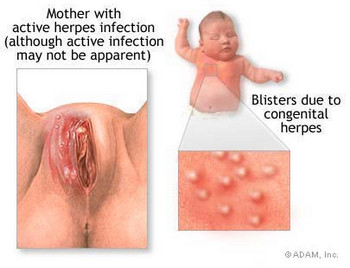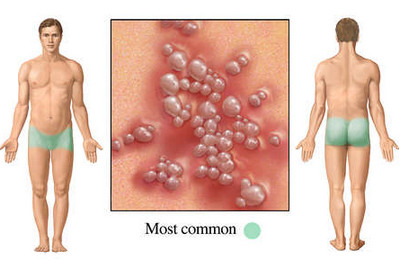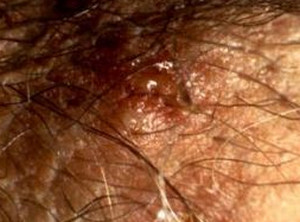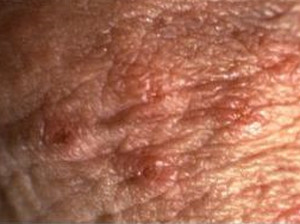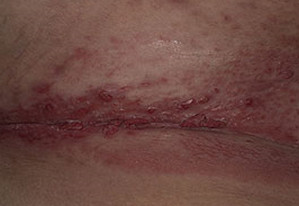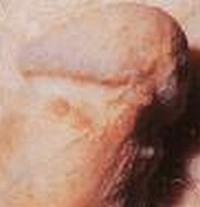What is Genital Herpes?
Genital herpes is common. This very contagious sexually transmitted disease is caused by a Herpes simplex virus. It is transmitted from one person to another usually during sexual contact and results in blisters or groups of small ulcers (open sores) on and around the genitals of both men and women.
In genital herpes, the viral infection is usually transmitted through intimate contact with the moist mucous linings of the genitals. The Herpes simplex virus enters the mucous membranes through microscopic tears . Contact is with the mouth, the vagina, the genital skin or the areas adjacent to infected skin. On entering the body, the virus moves to the nerve roots near the spinal cord and remains there in a dormant state until the next time the patient is vulnerable to an outbreak. In case of a herpes outbreak, the virus travels down the nerve fibers to the site of the infection. On reaching there, the skin turns red and blisters are formed.
Genital Herpes Outbreak
Outbreaks of genital herpes are closely related to the functioning of the immune system. The first outbreak is the most severe because the infected person wasn’t exposed to the virus before. Therefore the antibodies needed to protect the patient are not present to initiate an appropriate immune response.
At the location of the outbreak, the Herpes simplex virus gets into the skin cells and resumes multiplying and reproducing. This causes the skin to become red and sensitive. The infected area is painful and may itch, burn or tingle, during the outbreak.
The genital herpes virus remains for life in an infected person. When it is reactivated, the virus travels via nerve cells to the site of the original infection. However, the recurrences are usually shorter and less severe than the initial outbreak. In people with healthy immune systems, these outbreaks decrease in both severity and frequency over time. For the recurrent outbreaks, the healing occurs in half the time as the first outbreak.
Genital Herpes Cycle
The cycle of a typical genital herpes outbreak can be as follows:
- Inflammation —- Swelling, tenderness or redness is seen before the actual outbreak along with itching and sensitivity.
- Blisters —- Fluid-filled lesions, tiny red bumps, or rash may form. These resemble small fissures especially near the anus.
- Sores —- Small leaking ulcers known as ‘genital herpes sores’ can be seen when the skin on the blisters breaks. These sores or ulcers are small, round and wet looking.
- Crust —- The genital herpes sores begin to dry, scab and crust at the beginning of the healing process.
- Healing —- New skin is formed which appears slightly red or silver. The virus retreats into the nerves and lies dormant.
Female Genital Herpes
Also called as congenital herpes or herpes genitals, female genital herpes is seen in women who have suppressed immune systems, either through stress, disease or medications. These outbreaks are more frequent and last longer.
Initially, the visible signs of female genital herpes start as a usual small rash in the vaginal area which is hardly recognizable. For this reason, the first signs of female herpes symptoms are ignored by most of women as these are thought to be harmless pimples or acne. The lesions usually occur inside the vagina and in some cases may be visible outside. These lesions cause discomfort or vaginal discharge and are seen only during a doctor’s examination.
Male Genital Herpes
Male genital herpes is transmitted sexually. The symptoms include sores or lesions usually on or around the penis. The ulcers or blisters may be found anywhere around the genitals and also in and around the anus. Pain is experienced while urinating. Some men also experience additional symptoms of fever or a flu-like feeling, a burning pain, muscle aches, back pain and headaches. Some infected men also observe swollen glands and a pressure in the abdomen along with painful discharge from the penis. This will occur among men with less than healthy immune systems.
Use of condoms is recommended to avoid transmission of the genital herpes simplex virus. But it has been found that saliva can also transmit the Herpes virus. Moreover, the condom does not cover the whole of the genital area.
Genital Herpes Pictures
These pictures of genital herpes may be used to help you gain a better understanding.
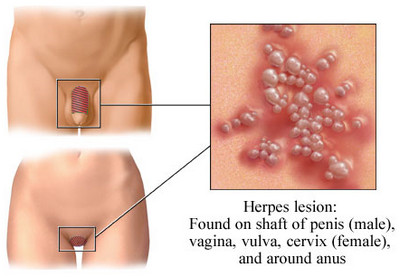
Wsource : herpessos.comhat does genital herpes look like on women
What does genital herpes look like on men
Picture : Herpes genitalis weeping blistser – HERPES SIMPLEX TYPE 2
Picture : Herpes genitalis blister on male penile shaft
Picture : Mild genital herpes
Photo : Penis warts – Mild dose ( MiPhoto Source : phil.cdc.govld genital herpes)
Genital Herpes Statistics
According to the Centers for Disease Control and Prevention, in the United States, almost 1 in every 5.81 teenagers and adults is infected with genital herpes. Surprisingly, women are most commonly infected than men. On an average, one of every four women has herpes. 1 in every 4.33 women is likely to have it while for men the average is 1 in 8.93. This may be possibly because male-to-female transmission of the virus is easier than female-to-male transmission.
Genital herpes is generally considered as purely an STD and hence safer sex is thought to greatly reduce the chances of transmission. But any restraint from sexual desires won’t necessarily keep you safe. The chances of a person aged 14-49 getting infected by HSV type-2 are 1 in 38.46, even if he or she had no sexual partners in his or her lifetime. On the other hand, the odds that a person who has had 50 or more sexual partners in his or her lifetime has genital herpes are 1 in 2.51.
But a substantial decrease has been noticed in cases of genital herpes. At least 45 million adults in the United States alone were found to be infected with genital herpes. But according to a 1999 to 2004 CDC survey, the percentage of those infected has been reduced from 21 to 17. Much of this decrease was to be in the 14 to 19 year age group.
High Risk Factors for Genital Herpes
Most people get infected by having sex with someone who is shedding the herpes virus either during an outbreak or an asymptomatic (without symptoms) period. People who are unaware about their herpes infection play an important role in the transmission of this disease.
Genital Herpes is extremely widespread because it is so contagious. Carriers can transmit the disease without having any symptoms of an active infection. Almost 90% of those infected, fail to recognize the symptoms or have no symptoms at all. The highest rates of infection are seen usually among the poor, those with less education, those addicted to cocaine or similar drugs and those with many sexual partners.
There are various reasons why so many people with herpes are undiagnosed. Many people never experience symptoms, and those that do may be too embarrassed to get tested due to the stigma of having a STD. But even those who go for a test may not get an accurate diagnosis. Antibodies to the virus sometimes takes months to develop in an infected person’s body, so tests taken soon after infection may produce negative results.
Genital herpes infections usually do not cause serious health problems in healthy adults. However, in persons with weak immune systems, the genital herpes outbreaks can be unusually severe and long lasting.
A pregnant woman diagnosed with genital herpes can pass the infection to her baby. A baby born with herpes might die or have serious brain, skin or eye problems. Babies who are born with herpes can improve with early detection and treatment. It is preferred to perform a C-section rather than a vaginal birth to minimize exposure if the woman has an active case of HSV2 at the time of labor. Mothers can infect their babies at birth. [7]
Genital herpes, just like other genital diseases that cause sores, plays a vital role in the spread of HIV infection. A person infected with herpes is at a higher risk of getting HIV. This may be due to the open sores caused by the herpes infection or by other factors in the immune system.
Recent Research on Genital Herpes Treatment and Prevention
Everyone states the primary preventive measure against genital herpes and other sexually transmitted diseases (STD) is abstinence or at the very minimum the course of following safe sex practices.
One recent Canadian study tested polyurethane condoms that were coated with silver nanoparaticles and found positive results. The presence of the silver on the condoms inhibited HSV 1 and 2 and some other bacterial and fungal infections. The silver coating bonded with the polyurethane and was not washed away with water. This was reported in the International Journal of Nanomedicine.[3]
Acknowledging that HSV-2 as an indicator of immune system deficiency suggests a connection with HIV (AIDS).[5] French researchers in Banqui, Africa tested the possibility that medication to treat genital herpes, among infected women, but possibly with no visible symptoms could be a step towards preventing HIV infections. [4]
Recognizing that strains of HSV-2 are developing resistance to antiviral medications, other sources are being investigated to find alternative substances which can effectively treat HSV-2. A Korean study reported examining a range of marine plants and animals, such as algae, mollusks, sponges, echinoderms, etc., as possible sources for these chemicals.[6]
You can easily see that genital herpes is a global concern. Seeking to prevent and treat it effectively has been a priority for several decades. Determining which approach to a preventive vaccine is an ongoing process in many countries.
References:
- http://www.webmd.com/genital-herpes/guide/sexual-health-genital-herpes
- http://www.mayoclinic.com/health/genital-herpes/DS00179
- http://www.ncbi.nlm.nih.gov/pubmed/23049252
- http://clinicaltrials.gov/show/NCT00158483?order=50
- http://www.ncbi.nlm.nih.gov/pubmed/22143115
- http://www.ncbi.nlm.nih.gov/pubmed/21782018
- http://nlm.nih.gov/medlineplus/genitalherpes.html

